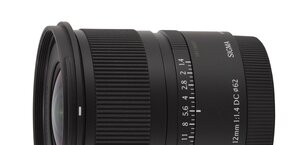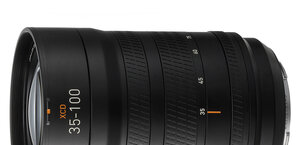Fujifilm Fujinon XF 8-16 mm f/2.8 R LM WR
8. Vignetting
Let’s glance at thumbnails below in order to assess the brightness loss of the tested lens for JPEG files we got with the help of the Fujifilm X-T2 camera.
| Fujifilm X-T2, JPEG, 8 mm, f/2.8 | Fujifilm X-T2, JPEG, 8 mm, f/4.0 |

|

|
| Fujifilm X-T2, JPEG, 12 mm, f/2.8 | Fujifilm X-T2, JPEG, 12 mm, f/4.0 |

|

|
| Fujifilm X-T2, JPEG, 16 mm, f/2.8 | Fujifilm X-T2, JPEG, 16 mm, f/4.0 |

|

|
Please Support UsIf you enjoy our reviews and articles, and you want us to continue our work please, support our website by donating through PayPal. The funds are going to be used for paying our editorial team, renting servers, and equipping our testing studio; only that way we will be able to continue providing you interesting content for free. |
- - - - - - - - - - - - - - - - - - - - - - - - - - - - - - - - - - - - - - - - - - - - - - - -
At the maximum relative aperture and the shortest focal length the vignetting amounts to 22% (−0.71 EV). With such parameters it is a very good result. Still that aberration decreases slowly on stopping down – by f/4.0 you get 19% (−0.61 EV), by f/5.6 the result is 14% (−0.44 EV) and only by f/8.0 the lens’s vignetting drops to an imperceptible level of 10% (−0.29 EV).
Similar numbers you get in the middle of the focal range and at that place the vignetting seems to be even more resistant to stopping down. The values we got by f/2.8, f/4.0, f/5.6 and f/8.0 are, respectively, 25% (−0.85 EV), 24% (−0.81 EV), 21% (−0.69 EV) and 16% (−0.52 EV).
The situation hardly changes after passing to the 16 mm focal length. In that case at the maximum relative aperture the brightness loss in the frame corners amounts to 21% (−0.69 EV) and then decreases to 19% (−0.63 EV) on stopping down the aperture to f/4.0. By f/5.6 you see a result of 16% (−0.50 EV), and by f/8.0 it’s 12% (−0.36 EV).
Now let’s check the vignetting performance in the case of RAW files developed by independent software like dcraw – appropriate thumbnails are shown below.
| Fujifilm X-T2, RAW, 8 mm, f/2.8 | Fujifilm X-T2, RAW, 8 mm, f/4.0 |

|

|
| Fujifilm X-T2, RAW, 12 mm, f/2.8 | Fujifilm X-T2, RAW, 12 mm, f/4.0 |

|

|
| Fujifilm X-T2, RAW, 16 mm, f/2.8 | Fujifilm X-T2, RAW, 16 mm, f/4.0 |

|

|
As you can notice, the results are much higher than in the case of JPEG images, the only thing in common is the resistance to stopping down. At the 8 mm focal length and by f/2.8 you have to take into account the loss of light in the corners amounting to 52% (−2.11 EV). It is a lot but such a value is justified by the huge angle of view (in the case of RAW files over 5 degrees wider than officially declared) and good aperture fastness. By f/4.0 the vignetting is 49% (−1.95 EV), by f/5.6 it reaches 46% (−1.77 EV), and by f/8.0 it gets to still a high value of 42% (−1.58 EV). Even by f/11 and f/16 apertures the problem remains visible because the aberration described here reaches respectively 39% (−1.41 EV) and 37% (−1.32 EV).
In the middle of the focal range the problems are just a tad smaller. By f/2.8 you see vignetting of 49% (−1.96 EV), which decreases slightly to 48% (−1.88 EV) on stopping down the aperture to f/4.0. By f/5.6, f/8.0 and f/11.0 you can notice this aberration without any problems as its level reaches respectively 44% (−1.69 EV), 41% (−1.52 EV) and 37% (−1.33 EV).
The best situation, but still far from good, can be seen at 16 mm. In that place by f/2.8 loss of light amounts to 45% (−1.73 EV) in the frame corners; on stopping down the aperture to f/4.0 its level decreases to 42% (−1.60 EV). By f/5.6 the vignetting is 38% (−1.40 EV) , dropping to 35% (−1.24 EV) when you employ f/8.0. By f/11.0 you can still notice light fall-off as it still amounts to 32% (−1.12 EV).
Lack of very distinct truncation of light circles we saw in the previous chapter might explain to some degree the vignetting performance of the Fujinon. The fact that this aberration is so resilient to stopping down suggest that telecentricity, or rather the lack of it, is the main factor you should take into account. As we mentioned before, the rear element actually sticks out of the mount and is situated very close to the sensor. With such short focal lengths, the rays of light have to fall on pixels of the detector at huge angles and one part of vignetting might be caused not only by optics itself but also by interactions of light waves with the microelements of the sensor. The fact that the efficiency of anti-reflective coatings decreases with the increase of the glancing angle is another factor. As you see the removal of the mirror chamber has also cons, not only advantages…
| Fujifilm X-T2, 8 mm, RAW, f/2.8 |
 |
| Fujifilm X-T2, 12 mm, RAW, f/2.8 |
 |
| Fujifilm X-T2, 16 mm, RAW, f/2.8 |
 |






